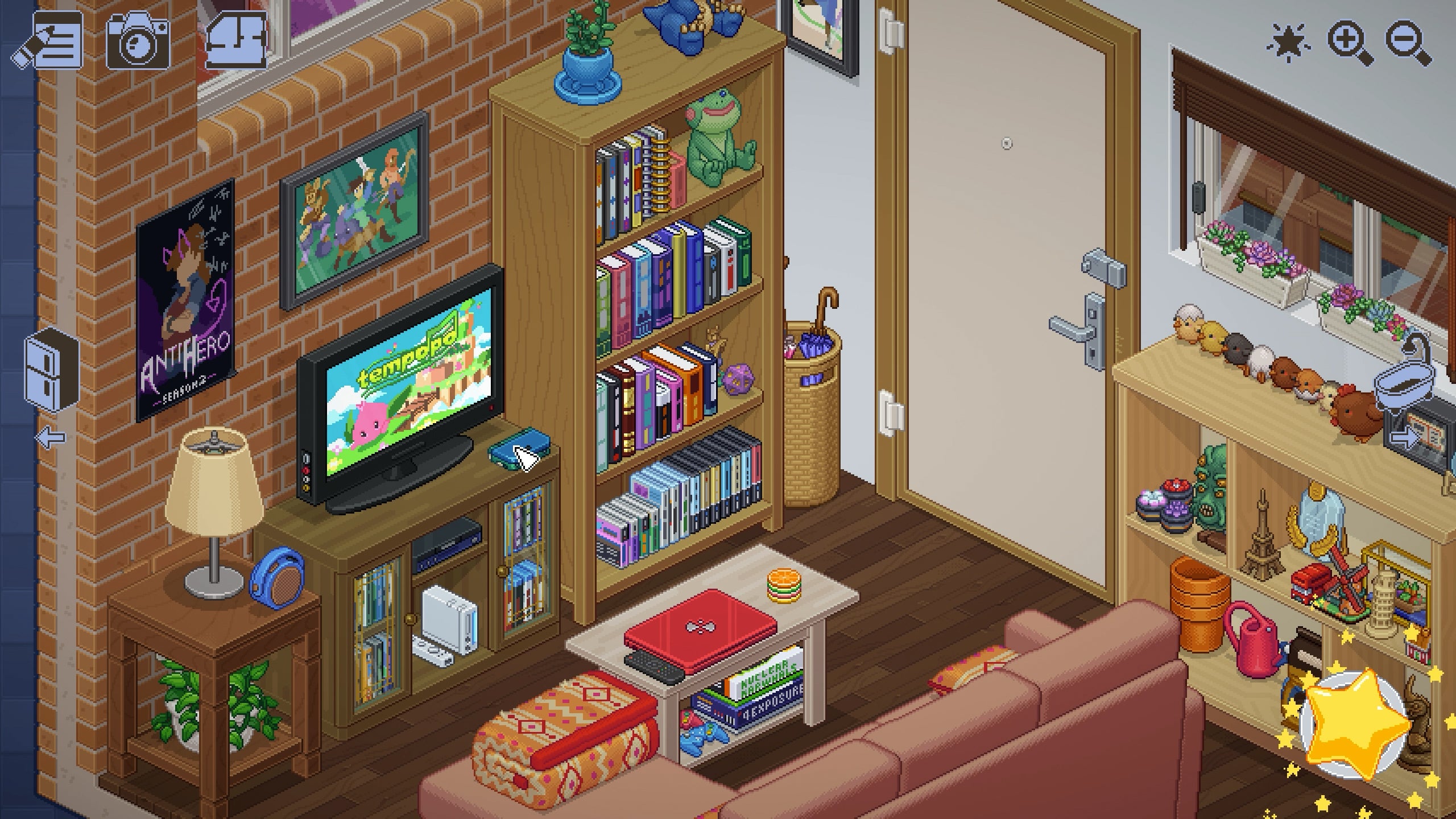I start to declutter the kitchen, only a few levels into Unpacking. I pulled out a rice cooker (zojirushi, nice choice), an all-to-familiar soy sauce bottle (although my family prefers to buy it in the gallon variety), and a myriad of spices that I could almost smell through the pixels. I organized this space as I had been conditioned to at home. Silverware arranged as you would lay them on a table, nesting pots and pans to then be placed on shelves, orienting the handles of mugs for ease of access. Unused baking equipment was to be stored in the oven itself when not in use, and naturally, the vertical striped towels were for drying and the horizontal textured ones were to be thrown on the oven handle. Yet, fully satisfied with the layout I had meticulously spent organizing, Unpacking rejected my system. The towels and pans flashed red, thrown in what was considered an unacceptable place. I navigated to other rooms, now noticing how other confined areas of space were, apparently, horrendously arranged.
How then, does our own conditioning play into how we navigate through Unpacking?
I feel for all players, we lived through our own narrative as we unpacked the main characters’ spaces. As we pulled off tape and rifled through the crumpled brown packing paper, we instinctively had an understanding of where each of the items should be placed. This notion of conditioning hinges on the word “should” however. Why do we feel these items have a designated space? How do we choose to then arrange this space in a procedural context?
Our conditioning regarding organization is starkly apparent as we place ourselves within the narrative of Unpacking. The awards and diplomas must be displayed, much like our own. Whether they be placed in the bedroom or the office, however, is entirely up to the discretion of the player. Oftentimes many of the items in Unpacking were sorted based upon the room they were in, making the unpacking process significantly easier as you organized the accumulated trinkets. Worn books, childhood toys, and a WIDE variety of hobby necessities poured out of the box, and the further I played, the more attached I grew to these pixelated objects. How players choose to arrange the books and toys may be linked to how their bedrooms were once arranged as a child. Moving to the final level, I was startled (and a bit annoyed) when I had to move every alphabet block from where I had organized them on the shelves in the baby’s room. I had to scatter them across the floor, creating what my mother would lovingly call “a parental death trap”. This refusal to let the player place any item anywhere is what draws them back into the procedural narrative. Not to be confused with the concept of procedurally generated narrative, in which case there would be a factor of randomness needed, but actually referring to the random and unpredictable nature of what you happen to pull from boxes.
This only builds as you insert your own preconceptions of where items “should” go. In many instances, laying out rooms as I had done yielded confusing results. Unpacking itself draws upon the natural mechanic of players designating where things should go. This game would be near impossible if it wasn’t reliant on the conditioning we have internalized from our youth. This instructional period of directing items where to go – again that notion of “should”- is integral to the story, as you wouldn’t be able to live out the character’s experience in an enjoyable manner without it.
Now, there is some comedy in pulling a shoe from a box placed in the kitchen, but in all honesty, the repetition of this joke fell flat when I had to continuously check every room as to where the object was “supposed” to go. I think the beauty of this game is found in how the players choose to interact with the environment, and when set spaces are designated for certain items, it limits that expression. In a similar vein, I felt areas such as the closet and the living room proved challenging when organizing objects. The repetitive nature was broken by objects needing to be placed elsewhere, and this disjointed aspect diminished how ingrained I felt with the story; it broke away from the cozy organizational game and instead planted seeds of frustration.
Overall, however, the game masterfully intertwined written narrative with one that players could relate to. I was in the process of living through the characters’ experience, organizing their dorm room in a similar fashion to how I constructed mine. When she moved into her boyfriend’s apartment, I couldn’t help but stop to ponder what that experience would be like. What systems of compromise would need to be established? Would they be similar to how she had the ability to reorganize spaces? Would there ever be a move-out period? I wanted this character to succeed, cheering her on throughout the game whilst also hoping that her ending was one I could also achieve. I wanted her success, because I could see myself succeeding as well.
So, in the future, when I move into my own space, the pans will be placed into the oven when not in use, and the towels will be organized as I see fit. I’ll be placing a guitar next to my keyboard, both of which would never be placed within a common living space contrary to the main character’s personal belief. There will be space for polaroids, mason jars housing plants, and all postcards will be hung up with pride. Naturally, the vertical striped towels will be for drying and the horizontal textured ones are to be thrown on the oven handle. I will not just unpack a house with objects, but a home with memories.

